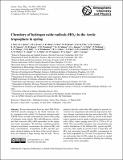| dc.contributor.author | Mao, Jialin | |
| dc.contributor.author | Jacob, Daniel J. | |
| dc.contributor.author | Evans, M. J. | |
| dc.contributor.author | Olson, J. R. | |
| dc.contributor.author | Ren, X. | |
| dc.contributor.author | Brune, W. H. | |
| dc.contributor.author | St. Clair, J. M. | |
| dc.contributor.author | Crounse, J. D. | |
| dc.contributor.author | Spencer, K. M. | |
| dc.contributor.author | Beaver, M. R. | |
| dc.contributor.author | Wennberg, P. O. | |
| dc.contributor.author | Cubison, M. J. | |
| dc.contributor.author | Jimenez, J. L. | |
| dc.contributor.author | Fried, A. | |
| dc.contributor.author | Weibring, P. | |
| dc.contributor.author | Walega, J. G. | |
| dc.contributor.author | Hall, S. R. | |
| dc.contributor.author | Weinheimer, A. J. | |
| dc.contributor.author | Cohen, R. C. | |
| dc.contributor.author | Chen, G. | |
| dc.contributor.author | Crawford, J. H. | |
| dc.contributor.author | McNaughton, C. | |
| dc.contributor.author | Clarke, A. D. | |
| dc.contributor.author | Jaeglé, L. | |
| dc.contributor.author | Fisher, J. A. | |
| dc.contributor.author | Yantosca, R. M. | |
| dc.contributor.author | Le Sager, P | |
| dc.contributor.author | Carouge, C. | |
| dc.date.accessioned | 2014-03-17T15:36:10Z | |
| dc.date.issued | 2010 | |
| dc.identifier.citation | Mao, Jialin, Daniel J. Jacob, M. J. Evans, J. R. Olson, X. Ren, W. H. Brune, J. M. St. Clair, et al. 2010. “Chemistry of Hydrogen Oxide Radicals \((HO_x)\) in the Arctic Troposphere in Spring.” Atmospheric Chemistry and Physics 10 (13) (July 1): 5823–5838. doi:10.5194/acp-10-5823-2010. http://dx.doi.org/10.5194/acp-10-5823-2010. | en_US |
| dc.identifier.issn | 1680-7316 | en_US |
| dc.identifier.issn | 1680-7324 | en_US |
| dc.identifier.uri | http://nrs.harvard.edu/urn-3:HUL.InstRepos:11913975 | |
| dc.description.abstract | We use observations from the April 2008 NASA ARCTAS aircraft campaign to the North American Arctic, interpreted with a global 3-D chemical transport model (GEOS-Chem), to better understand the sources and cycling of hydrogen oxide radicals \((HO_x≡H+OH+\)peroxy radicals) and their reservoirs \((HO_y≡HO_x+\)peroxides) in the springtime Arctic atmosphere. We find that a standard gas-phase chemical mechanism overestimates the observed \(HO_2\) and \(H_2O_2\) concentrations. Computation of \(HO_x\) and \(HO_y\) gas-phase chemical budgets on the basis of the aircraft observations also indicates a large missing sink for both. We hypothesize that this could reflect \(HO_2\) uptake by aerosols, favored by low temperatures and relatively high aerosol loadings, through a mechanism that does not produce H2O2. We implemented such an uptake of \(HO_2\) by aerosol in the model using a standard reactive uptake coefficient parameterization with \(\gamma(HO_2)\) values ranging from 0.02 at 275 K to 0.5 at 220 K. This successfully reproduces the concentrations and vertical distributions of the different \(HO_x\) species and \(HO_y\) reservoirs. \(HO_2\) uptake by aerosol is then a major \(HO_x\) and \(HO_y\) sink, decreasing mean OH and \(HO_2\) concentrations in the Arctic troposphere by 32% and 31% respectively. Better rate and product data for \(HO_2\) uptake by aerosol are needed to understand this role of aerosols in limiting the oxidizing power of the Arctic atmosphere. | en_US |
| dc.description.sponsorship | Earth and Planetary Sciences | en_US |
| dc.description.sponsorship | Engineering and Applied Sciences | en_US |
| dc.language.iso | en_US | en_US |
| dc.publisher | European Geosciences Union | en_US |
| dc.relation.isversionof | doi:10.5194/acp-10-5823-2010 | en_US |
| dash.license | LAA | |
| dc.title | Chemistry of Hydrogen Oxide Radicals \((HO_x)\) in the Arctic Troposphere in Spring | en_US |
| dc.type | Journal Article | en_US |
| dc.description.version | Version of Record | en_US |
| dc.relation.journal | Atmospheric Chemistry and Physics | en_US |
| dash.depositing.author | Jacob, Daniel J. | |
| dc.date.available | 2014-03-17T15:36:10Z | |
| dc.identifier.doi | 10.5194/acp-10-5823-2010 | * |
| dash.authorsordered | false | |
| dash.contributor.affiliated | Le Sager, P | |
| dash.contributor.affiliated | Mao, Jialin | |
| dash.contributor.affiliated | Jacob, Daniel | |


